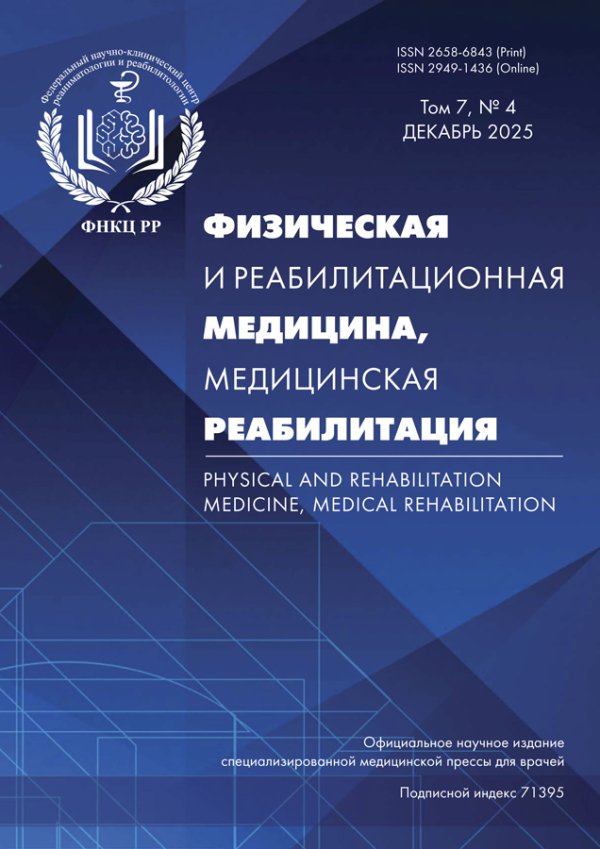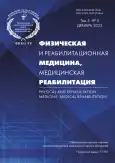Unrecognised autonomic dysreflexia in neurogenic lower urinary tract dysfunction with spinal cord injury as a reason for admission to a cardiac surgical unit
- Authors: Novoselova I.N.1,2, Bershadskii A.V.3,4, Popova O.V.1
-
Affiliations:
- Clinical and Research Institute of Emergency Pediatric Surgery and Trauma
- Russian Medical Academy of Continuous Professional Education
- Central City Clinical Hospital 6
- UGMK-Health
- Issue: Vol 5, No 4 (2023)
- Pages: 322-329
- Section: CASE REPORT
- URL: https://journal-vniispk.ru/2658-6843/article/view/250000
- DOI: https://doi.org/10.36425/rehab608180
- ID: 250000
Cite item
Full Text
Abstract
BACKGROUND: In Russia, spinal cord injury occurs in 0.7–6.8% of total injuries. Due to emergence of new rehabilitation protocols, it is extremely important to know the time of occurrence of consequences of spinal cord injury and adequate diagnosis of complications, which allows timely identification of life-threatening conditions of one of the body systems.
Clinical case description. We present a clinical case of autonomic dysreflexia in neurogenic lower urinary tract dysfunction after traumatic cervical spinal cord injury in a 17-year-old girl. In traumatic spinal cord injury above the level of the sixth thoracic vertebra, autonomic dysreflexia as a variant of autonomic dysfunction is a common complication. This clinical case will be of interest to clinicians of all specialties who encounter patients with spinal cord injury. It is shown that misinterpreted symptoms of increased blood pressure during bladder filling were the cause of observation and treatment by a cardiologist for arterial hypertension, as well as hospitalization in the cardiac surgery department for planned surgical treatment of renal artery stenosis, which was thought to be the cause of the episodic increases in blood pressure. Lack of knowledge about the presence of autonomic dysfunction in spinal cord injury patients may have led to unnecessary surgical treatment. During the joint management of the patient with a pediatric cardiac surgeon, signs of autonomic dysreflexia were detected against the background of traumatic spinal cord disease at the level of the cervical spine, hypotensive treatment and planned surgical intervention were canceled.
Conclusion. Subsequently, an adequate regimen of periodic bladder catheterization and antimuscarinic drug therapy was prescribed, which successfully reduced the dysreflexia.
Full Text
##article.viewOnOriginalSite##About the authors
Irina N. Novoselova
Clinical and Research Institute of Emergency Pediatric Surgery and Trauma; Russian Medical Academy of Continuous Professional Education
Author for correspondence.
Email: i.n.novoselova@gmail.com
ORCID iD: 0000-0003-2258-2913
SPIN-code: 1406-1334
MD, Dr. Sci. (Med.)
Russian Federation, 20 Bolshaya Polyanka street, 119180 Moscow; MoscowArtem V. Bershadskii
Central City Clinical Hospital 6; UGMK-Health
Email: natsia@gmail.com
ORCID iD: 0000-0002-5256-8410
SPIN-code: 9827-7094
MD, Cand. Sci. (Med.)
Russian Federation, Ekaterinburg; EkaterinburgOlga V. Popova
Clinical and Research Institute of Emergency Pediatric Surgery and Trauma
Email: oglapopova@mail.ru
ORCID iD: 0000-0003-4434-0659
SPIN-code: 5125-6980
Russian Federation, 20 Bolshaya Polyanka street, 119180 Moscow
References
- Morozov IN, Mlyavykh SG. The epidemiology of vertebral-cerebrospinal trauma. Medical almanac. 2011;(4):157–159.
- Novoselova IN, Ponina IV, Valiullina SA. The classification of consequences and complications of spinal cord injury in children. Physical and rehabilitation medicine, medical rehabilitation. 2022;4(4):234–243. doi: 10.36425/rehab114841
- Panicker JN, Fowler CJ, Kessler TM. Lower urinary tract dysfunction in the neurological patient: Clinical assessment and management. Lancet Neurol. 2015;14(7):720–732. doi: 10.1016/S1474-4422(15)00070-8
- Karlsson AK. Autonomic dysreflexia. Spinal Cord. 1999;37(6): 383–391. doi: 10.1038/sj.sc.3100867
- Cragg J, Krassioukov A. Autonomic dysreflexia. CMAJ. 2012; 184(1):66. doi: 10.1503/cmaj.110859
- Clinical recommendations “Neurogenic dysfunction of the lower urinary tract”. Russian Society of Urologists; 2019. (In Russ). Available from: https://ooorou.ru/library/russian-guidlines/. Accessed: 15.11.2023.
- Thompson CE, Witham AC. Paroxysmal hypertension in spinal cord injuries. New Engl J Med. 1948;239(8):291–294. doi: 10.1056/NEJM194808192390803
- Mathias CJ, Christensen NJ, Corbett JL, et al. Plasma catecholamines during paroxysmal neurogenic hypertension in quadriplegic man. Circ Res. 1976;39(2):204–208. doi: 10.1161/01.res.39.2.204
- McGuire TJ, Kumar VN. Autonomic dysreflexia in the spinal cord injured: What physicians should know about this medical emergency. Postgrad Med. 1986;80(2):81–84, 89. doi: 10.1080/00325481.1986.11699484
- Young JS. Use of guanethidine in control of sympathetic hyperreflexia in persons with cervical and thoracic cord lesions. Arch Phys Med Rehabil.1963;(44):204–207.
- Ascoli R. The neurovegetative syndrome of vesical distention in paraplegics: Prevention and therapy. Paraplegia. 1971;9(2):82–84. doi: 10.1038/sc.1971.13
- Cowan H, Lakra C, Desai M. Autonomic dysreflexia in spinal cord injury. BMJ. 2020;371:m3596. doi: 10.1136/bmj.m3596
- Novoselova IN. Autonomous dysreflexia syndrome in patients with spinal cord trauma consequences. Detskaya i podrostkovaya reabilitatsiya. 2019;(1):26–32.
- Lindan R, Joiner E, Freehafer AA, Hazel C. Incidence and clinical features of autonomic dysreflexia in patients with spinal cord injury. Paraplegia. 1980;18(5):285–292. doi: 10.1038/sc.1980.51
- Snow JC, Sideropoulos HP, Kripke BJ, et al. Autonomic hyperreflexia during cystoscopy in patients with high spinal cord injuries. Paraplegia. 1978;15(4):327–332. doi: 10.1038/sc.1977.49
- Furlan JC. Headache attributed to autonomic dysreflexia: an underrecognized clinical entity. Neurology. 2011;77(8):792–798. doi: 10.1212/WNL.0b013e31822afff1
- Canon S, Shera A, Phan NM, et al. Autonomic dysreflexia during urodynamics in children and adolescents with spinal cord injury or severe neurologic disease. J Pediatr Urol. 2015;11(1):32.e1–4. doi: 10.1016/j.jpurol.2014.08.011
- Wan D, Krassioukov AV. Life-threatening outcomes associated with autonomic dysreflexia: A clinical review. J Spinal Cord Med. 2014;37(1):2–10. doi: 10.1179/2045772313Y.0000000098
- Consortium for Spinal Cord Medicine. Acute management of autonomic dysreflexia: individuals with spinal cord injury presenting to health-care facilities. J Spinal Cord Med. 2002; 25(Suppl. 1):S67–88.
Supplementary files








